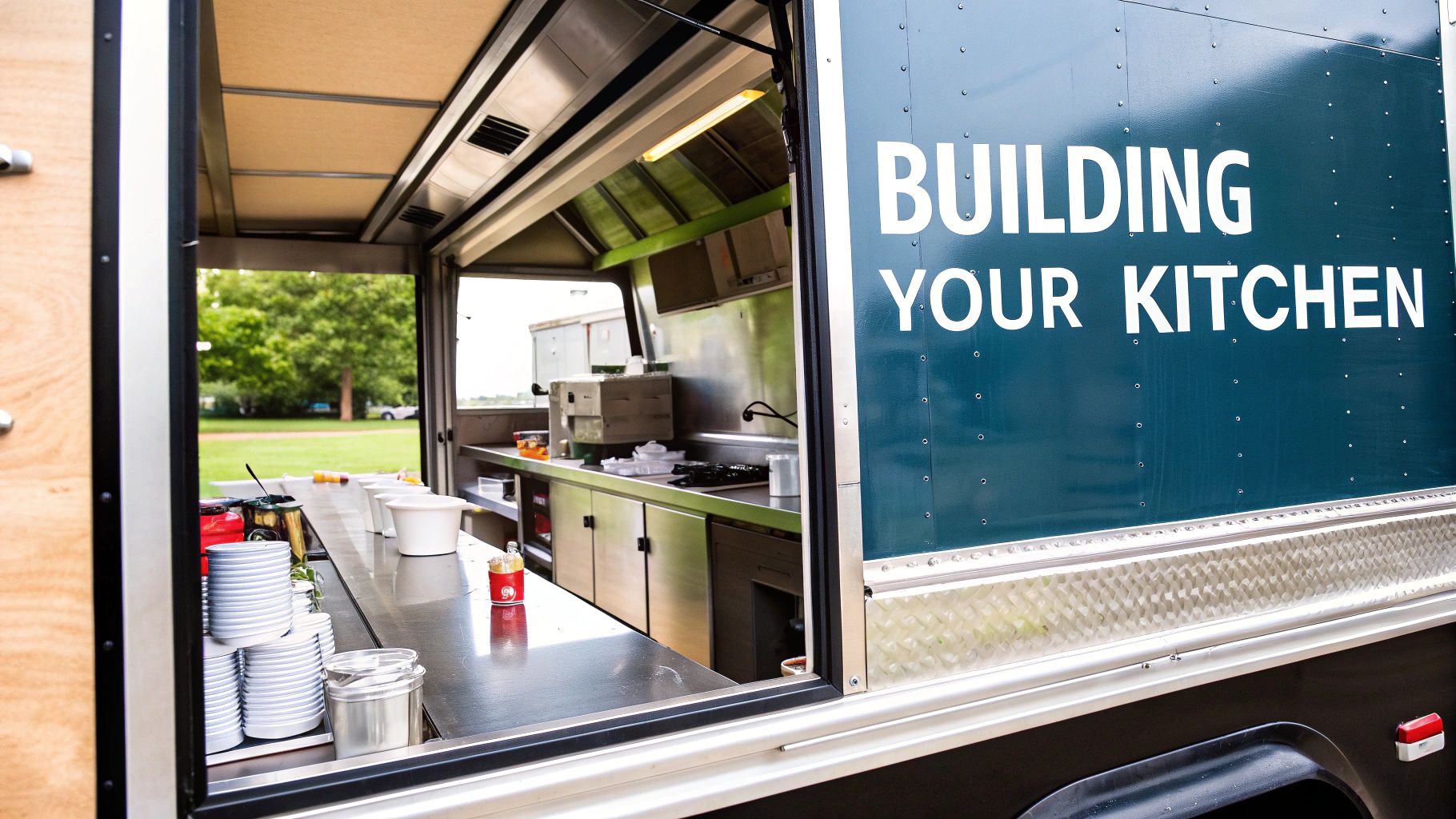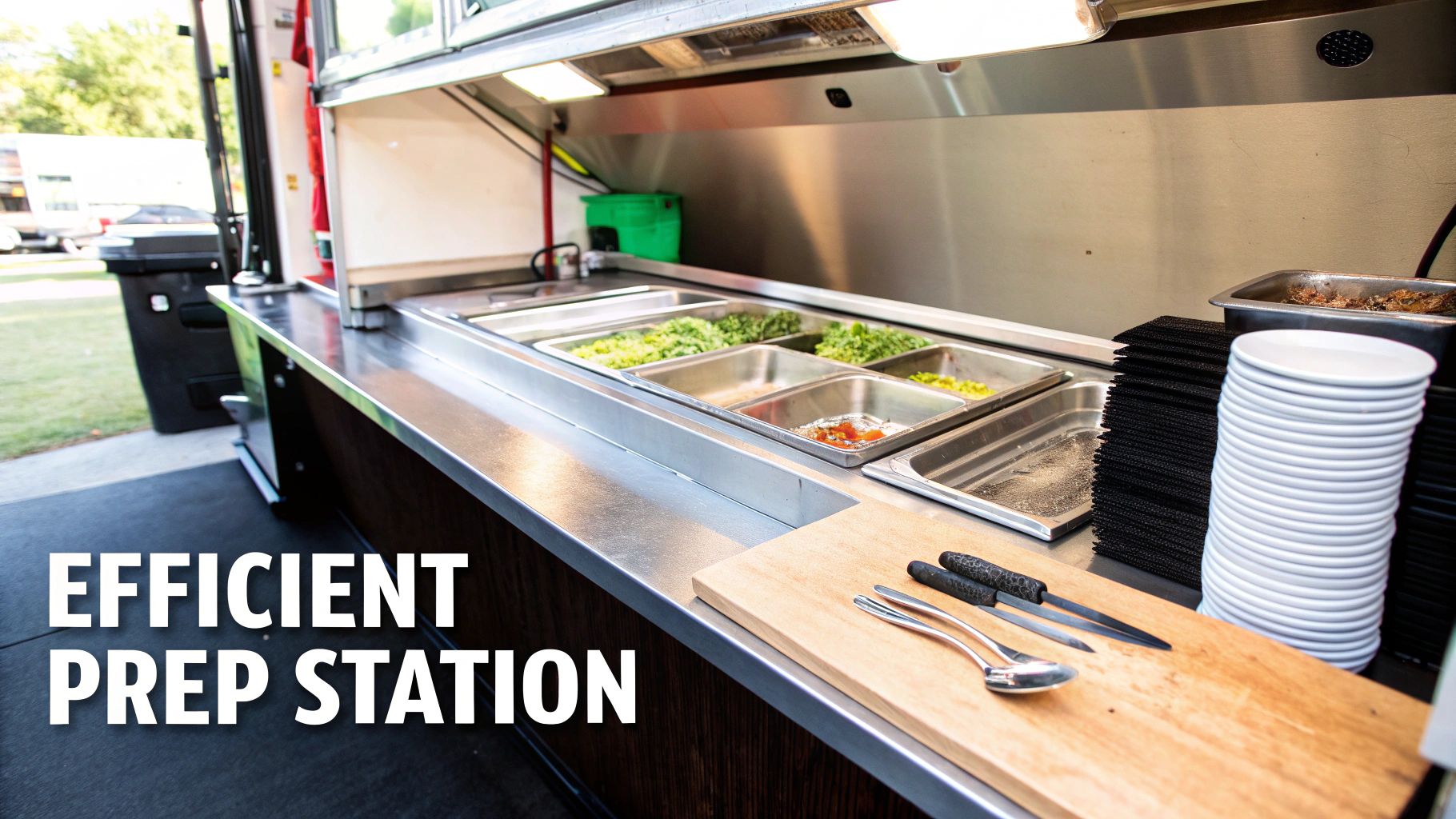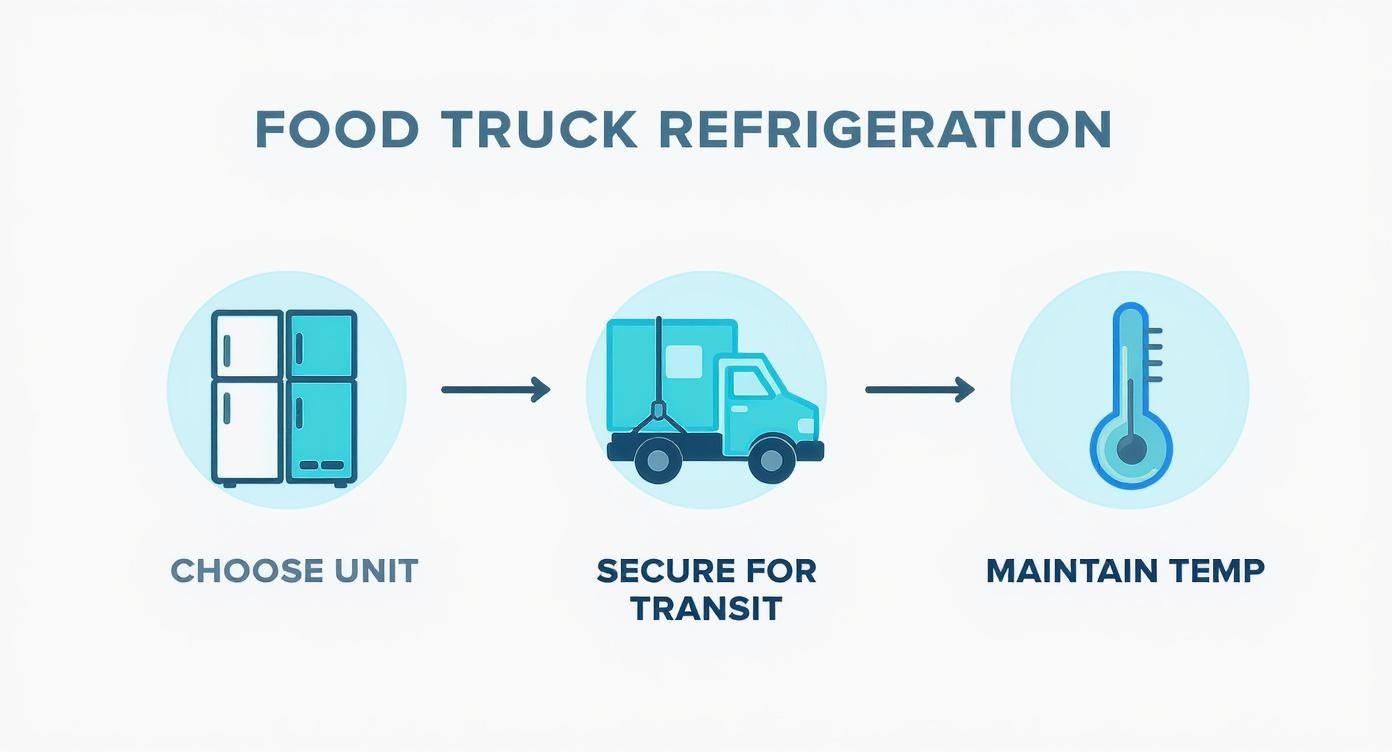
Essential Appliances for Food Trucks
Share
Picking the right appliances for your food truck is the very first step in designing a mobile kitchen that’s not just functional, but profitable. This isn't just about what you cook with; it’s about building a seamless workflow that can smash the lunch rush, keep the health inspector happy, and make every single square inch count.
Building Your Kitchen on Wheels
Welcome to the engine room of your food truck. Forget the romance for a second and let's get into the nuts and bolts of building a kitchen that actually works on the road. Your success really hinges on the decisions you make long before you serve your first customer. Think of it like drawing up a blueprint for a business that’s designed to win from day one.

This guide is going to walk you through all the core pieces you need to outfit your truck. We'll cover everything from the main cooking line to refrigeration, power sources, and the safety systems you can't ignore. Every appliance choice you make has a ripple effect on everything else, creating a web of decisions that will ultimately define what your truck can do.
Understanding the Core Components
A great food truck kitchen isn't just a random assortment of equipment—it's a system where every piece works together. You'll want to focus on three main areas:
- Cooking Line: This is where the magic happens. It’s the heart of your operation, with the griddles, fryers, and ovens that bring your menu to life.
- Prep and Storage: Efficient prep tables, sinks, and refrigeration are the unsung heroes here. They’re what make speed and organization possible when you're slammed.
- Power and Ventilation: A solid generator and a proper ventilation hood are completely non-negotiable. They're critical for both safety and basic functionality.
And don't forget, what's on the outside matters just as much as what's on the inside. Attracting a crowd starts with a great look, and things like custom vehicle wraps can make a huge difference.
Planning for Success
Before you even think about buying a single piece of steel, you have to think about how your menu, your space, and your power supply all connect. A power-hungry beast like a deep fryer, which can suck down 60,000 to 100,000 BTUs per hour, is going to demand a serious propane setup and a beefy ventilation system. In the same way, loading up on coolers and freezers will put a heavy strain on your generator.
A rookie mistake we see all the time is underestimating the total power draw of all the appliances running at once. Always, always calculate your peak electricity and gas needs to make sure your power sources can handle the heat during a busy service.
When you carefully plan your kitchen layout and pick appliances that actually make sense for your menu, you create an environment built for speed. That initial time spent planning pays you back over and over by cutting down on bottlenecks, keeping your crew safe, and ultimately, making you more money.
Designing an Efficient Food Prep Station
In the tight quarters of a food truck, your prep station is your command center. Let's be honest, a smart layout here isn't a luxury—it's the engine that drives your service speed and keeps you sane during a dinner rush. This is where the unsung heroes of appliances for food trucks, your prep tables, really get to shine.

Choosing the right stainless steel surfaces is about more than just finding a spot to chop onions. It's a strategic move that builds a clean, durable, and lightning-fast workflow, letting you bang out orders with precision. Let’s break down the different types of prep tables that are the foundation of any top-tier food truck kitchen.
The Workhorse: Your Stainless Steel Prep Table
Think of a standard stainless steel prep table as the main stage for all your culinary action. It’s a tough, non-porous surface that’s ridiculously easy to clean and sanitize, which is non-negotiable for passing health inspections. The grade of steel matters, too. Most commercial tables use either 304 or 430-grade stainless steel. While both are tough, 304-grade offers better corrosion resistance, making it a smarter long-term bet against the constant moisture and cleaning chemicals in a kitchen.
These foundational tables come in a few key setups, each solving a different organizational puzzle:
- Standard Work Tables with Undershelves: This is your classic, most versatile choice. You get a simple, flat work surface with an open shelf below, which is perfect for stashing bulky items like ingredient bins, small appliances, or Cambro containers.
- Tables with Backsplashes: It’s a small feature, but a crucial one. A backsplash is just a raised lip along the back of the table. It stops food, liquids, and utensils from falling behind the unit or splashing onto your truck walls, which makes cleanup so much easier.
- Cabinet Base Tables: If you want a more organized, enclosed storage setup, these tables have stainless steel cabinets with sliding or hinged doors instead of an open shelf. This design is great for protecting items from dust and splashes and gives your kitchen a cleaner, more put-together look.
Supercharge Your Workflow with Specialized Prep Tables
When your menu is all about assembling items like sandwiches, salads, burritos, or pizzas, a specialized prep table isn't just nice to have—it's essential for pumping out a high volume of orders. These units are cleverly designed to combine a workspace, refrigerated ingredient storage, and cold backup storage into one compact footprint.
This all-in-one setup creates an incredibly efficient "Mise en Place" station where a cook has everything they need within arm's reach, cutting out wasted steps. To really see how these can transform a kitchen, it's worth exploring the benefits of a quality food prep table in a professional environment.
Sandwich Prep Tables
A sandwich prep table (or "sandwich unit") is a total game-changer for delis, cafes, and any truck slinging sandwiches or salads. The top section has a line of refrigerated wells—what we call a "cold rail"—designed to hold standard-sized food pans full of sliced meats, cheeses, veggies, and sauces.
Right in front of that cold rail is a cutting board, giving you an immediate workspace. Below, a refrigerated cabinet offers plenty of room for backup ingredients. This layout allows one person to build an entire order from start to finish without taking a single step, which dramatically cuts down your ticket times.
Pizza Prep Tables
In the same way, a pizza prep table is built specifically for the pizzeria workflow. These tables recognize that pizza toppings need bigger containers. They feature a raised, refrigerated rail that's wider and deeper to fit full-size food pans for sauce, cheese, and all the good stuff.
The work surface is also much deeper than a standard table, giving you the space you need to stretch dough and build large pies. And just like sandwich units, they have refrigerated cabinets underneath for storing dough boxes and extra ingredients.
By building refrigeration right into the assembly line, these specialized tables create a powerful workflow that's almost impossible to match with separate appliances. This efficiency is a core strategy for any food truck that relies on speed to make money during peak hours.
Choosing Your Refrigeration and Cold Storage
Your cooking line might get all the glory, but don't forget the silent partner that truly keeps your food truck in business: reliable refrigeration. This is a non-negotiable part of your setup, protecting thousands of dollars in inventory and making sure every single dish you serve is safe. Picking the right appliances for food trucks in this category means finding units built to handle the wild ride of a mobile kitchen.
Commercial-grade refrigeration is tough. It's designed to take the vibrations, bumps, and crazy temperature swings of life on the road. Unlike the fridge in your home kitchen, these units have beefy compressors and a solid build that can maintain safe food temps, even on a scorching day with your service window wide open. Get this choice right, and you'll prevent spoilage, keep the health inspector happy, and protect your profits.
Undercounter vs. Reach-In Units
The first big decision you'll make is whether to go with compact undercounter models or their bigger reach-in siblings. This really comes down to your menu's complexity, how much food you plan to sell, and the precious square footage you have to work with.
- Undercounter Refrigerators and Freezers: These are the space-saving heroes of the food truck world. They tuck neatly under your countertops, giving you back valuable workspace while keeping cold storage right where you need it. Their smaller footprint makes them perfect for tight kitchens or for holding specific ingredients right on the prep line.
- Reach-In Refrigerators and Freezers: If you're a high-volume truck or your menu relies on a lot of bulky ingredients, a reach-in is a must-have. These are the larger, upright models that offer way more storage capacity. Sure, they take up more floor space, but they let you buy in bulk and keep a deeper inventory on hand—a total game-changer during a slammed event.
Key Factors for Mobile Refrigeration
It's not just about size. A few other factors are absolutely critical when you're picking out a fridge or freezer that has to perform on the move. A commercial refrigerator is a serious investment, so you want to nail this decision the first time.
Energy efficiency is a massive deal. Your refrigerator will be one of the biggest and most consistent power hogs on your generator. An ENERGY STAR® certified unit can slash energy use by up to 35% compared to standard models. That means less strain on your generator and real savings on fuel costs over time. You can get a deeper look at balancing features in our guide to choosing a commercial refrigerator.
Always remember, a food truck is a vehicle first and a kitchen second. Your refrigeration units have to be bolted down or secured with heavy-duty straps. This prevents them from sliding around or tipping over in transit, a critical safety step that protects your gear and your crew.
Finally, think durability. You want units with stainless steel construction, reinforced door hinges, and heavy-duty casters. These are the features that ensure your appliance can handle the constant rattling and jostling of the road without giving up on you. Investing in a tough, efficient, and properly secured refrigeration system is one of the smartest moves you can make for the long-term health of your food truck.
Powering Your Truck and Ensuring Safety
Even the most impressive cooking appliances are just fancy metal boxes without a reliable power source and the right safety gear. Think of your power and ventilation systems as the heart and lungs of your mobile kitchen—they’re what keep everything running smoothly and, most importantly, safely. Getting these two areas right is non-negotiable for passing inspections and just plain surviving the daily grind.
This infographic breaks down what you need to know about your mobile refrigeration, from picking the right unit to keeping it secure on the road.

As you can see, a solid refrigeration strategy is about more than just buying a cooler. It’s a whole process that includes properly securing it for travel and constantly monitoring those temps to keep your food safe.
Choosing the Right Generator
Your generator is the lifeblood of your operation, and picking the right one starts with some simple math. You have to figure out the total electrical load of every single appliance you plan to run at the same time. Add up the starting wattage (that initial jolt of power an appliance needs to kick on) and the running wattage for everything from your fridge to your phone charger.
A classic rookie mistake is buying a generator that only covers the running wattage. You have to size your generator to handle the peak starting wattage of all your equipment combined, then add an extra 10-20% buffer so you don't burn it out.
Once you know your power requirements, you can start shopping. Inverter generators are a fantastic choice for food trucks. They're way quieter and more fuel-efficient than the conventional clunkers, which is a massive win when you’re trying to serve customers without sounding like a construction site.
Propane and Alternative Power Solutions
While electricity handles a lot, propane is the undisputed king of high-heat cooking. Most deep fryers and griddles run on propane because it delivers a ton of heating power, fast. A standard 40-pound propane tank holds about 860,000 BTUs of energy, but a hungry deep fryer can chew through 100,000 BTUs an hour. That’s why you’ll see most trucks carrying at least two tanks—running out mid-lunch rush is a nightmare.
There’s also a growing trend toward more sustainable power. The rise of all-electric food trucks, a market growing at a 19.05% CAGR, signals a future with lower daily operating costs and zero emissions. This shift is happening because of new regulations and owners looking for long-term savings. The appliances you choose are directly tied to these big-picture energy decisions.
When you're thinking about dependable power for your truck, understanding essential battery technologies for off-grid power is a game-changer for keeping things running smoothly.
Critical Safety: Your Hood Vent and Fire Suppression
A professional-grade ventilation hood isn’t just a nice-to-have; it's a mandatory piece of safety equipment. Its job is to suck all that grease-filled vapor, smoke, and intense heat away from your cooktop and shoot it outside. This not only keeps your workspace from becoming an oven but is also one of the first things a health or fire inspector will look at.
Working hand-in-hand with the hood is your fire suppression system—your ultimate safety net. Required by NFPA 96 standards, these systems automatically detect and extinguish fires, zeroing in on high-risk equipment like your deep fryer.
A complete system includes:
- Nozzles: Aimed directly over each of your cooking appliances.
- Chemical Agent: A special wet chemical made to smother grease fires (that’s a Class K fire).
- Manual Pull Station: A bright red handle your staff can pull in an emergency.
You absolutely must have this system inspected by a licensed pro every six months. They check everything from the chemical levels to the nozzle placement. Skipping this service is a huge red flag and can get you shut down on the spot. Together, your hood and suppression system create a safe kitchen that protects you, your staff, and your customers.
Optimizing Your Food Truck Layout
The best appliances in the world won't save a poorly designed kitchen. The real secret ingredient to a profitable—and sane—food truck operation is arranging your equipment for a seamless, intuitive workflow. This is especially true when your entire kitchen is smaller than most walk-in closets.
A thoughtful layout is all about minimizing wasted steps and shaving precious seconds off every single order. Getting this right is more important than ever. The food truck industry is set to hit a revenue of USD 2.8 billion by 2025, having grown at a blistering 13.2% annually over the last five years. This boom is driven by customers hungry for unique meals, which pushes owners like you to design hyper-efficient kitchens.
Assembly-Line vs. Zone-Based Layouts
The right layout for your truck boils down to one thing: your menu. Think of it like a factory floor. You want your raw ingredients to move smoothly through production and out the window to a happy customer with as few hitches as possible.
Two proven strategies get the job done:
- The Assembly-Line Model: This linear approach is a no-brainer for focused menus like tacos, sandwiches, or burgers. Each station is set up in sequential order: prep, cook, and finish. Your crew can grab a tortilla, move to the griddle for meat, then slide over to the topping station without ever backtracking. It's pure efficiency.
- The Zone-Based Model: If your menu is more complex with items that have different cook times, a zone-based setup is your friend. You create distinct "zones" for different tasks—a frying zone, a grilling zone, and a cold prep/salad zone. This lets multiple cooks work on different orders at the same time without tripping over each other.
To help you visualize how these concepts work in the real world, here’s a look at how different menus can shape your truck's design.
Sample Food Truck Layout Concepts
This table compares different layout strategies, showing how your menu and operational focus can dictate the most efficient workspace design.
| Layout Type | Best For | Key Feature | Workflow Example |
|---|---|---|---|
| Assembly-Line | Simple, high-volume menus (tacos, burgers) | Linear, sequential station placement | An order comes in. Staff member one builds the base, passes it to staff member two at the grill, who then passes it to staff member three for toppings and service. |
| Zone-Based | Complex, diverse menus (gourmet bowls, fusion) | Designated areas for specific tasks (fry, grill, cold prep) | Cook A is at the fryer handling appetizers, while Cook B is at the griddle working on the main course. Both can work independently without crossing paths. |
| Ergonomic Triangle | Smaller trucks with 1-2 operators | Key stations (fridge, cooktop, sink) form a tight triangle | A solo chef can pivot between the prep cooler, the flat-top, and the service window with just a step or two, minimizing movement and fatigue. |
| Galley Kitchen | Long, narrow truck shells | Two parallel counters or equipment lines | One side is dedicated to hot-line cooking, while the parallel side is used for cold prep, plating, and the service window, creating two distinct work lanes. |
Ultimately, the goal is to create a layout that feels intuitive for your specific menu and team. A well-designed space not only speeds up service but also makes the daily grind much less stressful for your staff.
Practical Tips for a Flawless Workflow
Once you’ve picked a model, it's time to sweat the small stuff. The goal is to build a space where every movement feels natural and effortless. An efficient layout can directly slash ticket times, keeping customers happy and the line moving.
A critical but often overlooked step is separating your service window from your cooking line. Creating a distinct path for taking orders and handing out food prevents staff from bumping into each other and keeps the customer-facing area clear of kitchen chaos.
This separation is just one piece of the puzzle. For a deeper dive, our comprehensive guide on designing effective food truck layouts offers more detailed strategies for making the most of your limited space. By thinking through every step of your process, you can build a kitchen that feels spacious and operates with machine-like precision. That means less stress for your team and more money in your pocket.
Answering Your Top Appliance Questions
When you're starting a food truck, the sheer number of appliance choices can feel like a mountain to climb. New or used? Gas or electric? What do I really need to get started? This section cuts through the noise with clear, straightforward answers to the questions we hear most from new operators.
Making the right calls now will save you a world of hurt and costly headaches later. Let's tackle these big questions so you can build your kitchen on wheels with confidence.
New vs Used Appliances What Is the Smartest Choice?
The new versus used debate is one of the first big financial decisions you’ll face. Brand-new equipment is a beautiful thing—it comes with a manufacturer's warranty, it's in pristine condition, and it has all the latest energy-saving features. Of course, that all comes with a much higher price tag.
On the flip side, used appliances can save you a massive 40-70% off the sticker price, which frees up a ton of cash you can use elsewhere. The trade-off? No warranty and the risk of pre-existing wear and tear. If you decide to go the used route, make sure you buy from a reputable dealer who has properly inspected and refurbished the gear.
The Single Most Important Appliance on a Budget
If your budget is stretched thin and you can only really splurge on one key item, make it your main cooking appliance. Whether that's a commercial griddle, a deep fryer, or a range, this is the workhorse that actually makes you money.
Think of your main cooking unit as the heart of your menu and the engine of your sales. Putting your money into a reliable, high-quality piece here means you can crank out your signature dishes without equipment failure derailing you during a crazy lunch rush.
Extending the Life of Your Equipment
Simple, consistent maintenance is the secret to protecting your investment. You need to create a daily and weekly cleaning schedule for every single appliance, especially focusing on getting rid of grease buildup. Routinely check your gas hoses for leaks, clean the coils on your refrigerators to keep them running efficiently, and keep the blades on your slicers sharp.
A well-maintained appliance doesn't just last longer—it runs more efficiently, which saves you real money on fuel and electricity costs over time.
Ensuring Your Appliances Meet Health Codes
Before you even think about buying a single piece of equipment, get a copy of your local health department’s requirements. This is non-negotiable. They will almost certainly specify that you need NSF-certified equipment, which is a guarantee that it's built for commercial use and is easy to properly sanitize.
They also have strict rules about sink setups (you'll need a three-compartment sink plus a separate handwashing sink) and will require a professional fire suppression system that meets NFPA 96 standards. Always, always get the official rulebook from your local jurisdiction first.
At PrepTables.com, we provide the durable, NSF-certified equipment you need to build a successful and compliant food truck kitchen. From stainless steel work tables to commercial refrigeration, we have the professional-grade appliances that stand up to the demands of the road. Explore our full collection at https://preptables.com to find the perfect foundation for your mobile business.
